#31 Oct each year is observed as World Cities Day and was first celebrated in 2014. This year’s global observance is planned a under the them
Explore tagged Tumblr posts
Text
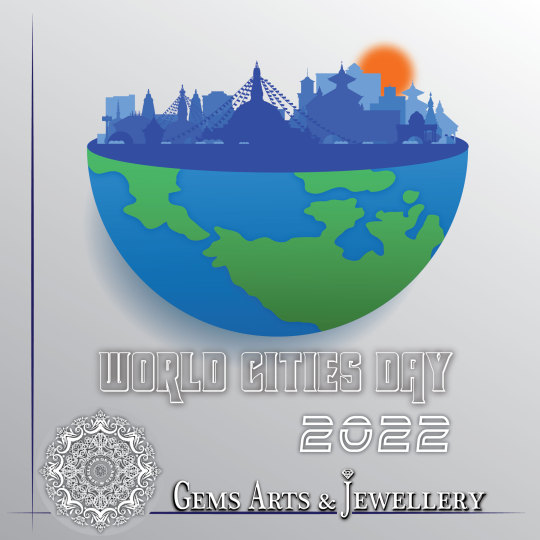
#31 Oct each year is observed as World Cities Day and was first celebrated in 2014. This year’s global observance is planned a under the them#more equitable and sustainable cities.#Let's join our hands to form a collective effort with a goal to make our cities livable#breathable#and green!#- Gems Arts & Jewellery#gemsartsjewellery#WorldCitiesDay#world#worldtravel#Nepal#kathmandu#kathmandunepal#kathmanduvalley#kathmandudairies#Lazimpat#diamond#diamonds#gold#silver#gems#ring#earring#necklace#bracelets#bangles#nosering#anklets#diamondring#repair
2 notes
·
View notes
Text
When you visit Hangzhou, you cannot miss West Lake. It’s a center attraction and is a heritage site declared by UNESCO World Heritage. The greenery around the lake is absolutely beautiful. It is so nice to have a relaxing walk around the area.

The West Lake displays different shades of beauty in different weather and season. So, you can visit it anytime of the year. There were many lotuses on the lakes and the dew was shinny under the sun on the leaves. Sometimes dragonflies would fly in the low air. What a beautiful picture it is! We took a lot of photos there as attracted by the view of the West Lake.

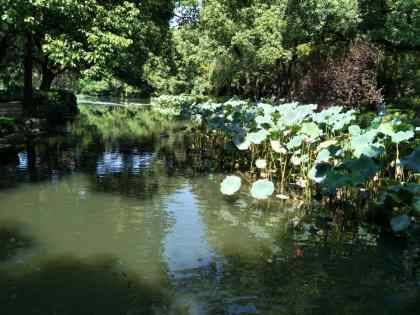


We spent a few hours here. Taking a boat cruise on the West Lake is the best way to view numerous cultural sites, Pagodas and Temples, also the artificial lakes with many willows, their draping foliage, all so utterly mesmerizing.
There was not a single piece of trash in the water, and the lakeside was unspoiled by commercial development. The lake and its surroundings exude a hazy feeling and that is what is special. The lake feels a world away from the hustle and bustle of the city.
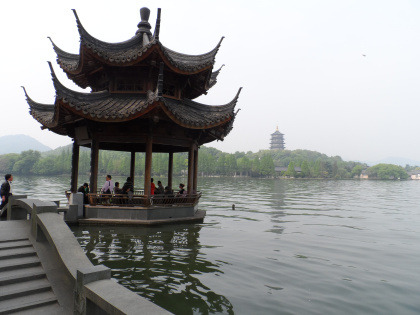
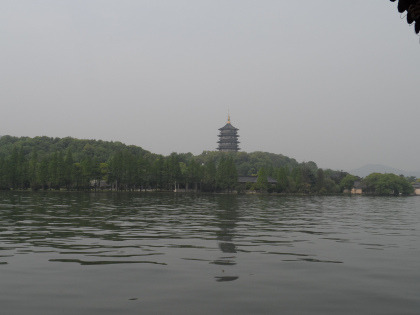
The landscape around the lake is really beautiful and there are several boat options to enjoy the artificial islands inside and lots of beautiful gardens, monuments or museums around the lake.
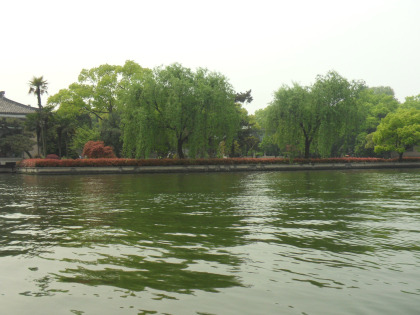
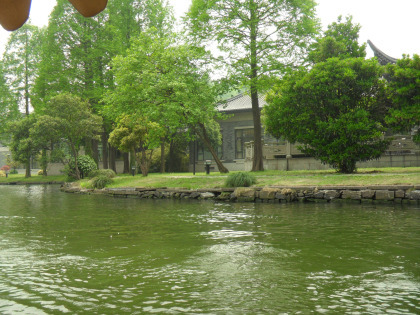



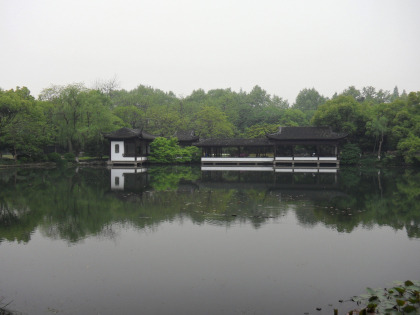
From center island, we took another boat to the other side of the lake which has the Lei Feng Pagoda. There are countless pagodas and temples in Hangzhou, but the pagoda we highly recommend is the Lei Feng Pagoda.
This pagoda can be seen everywhere and it stands on a small hillside by the lake, rises to the sky and overlooks the area. The road to the top floor of the pagoda is short, only five floors and if you do not want to climb the stairs, you can choose between riding an escalator or taking steps to reach the pagoda on top of the hill.
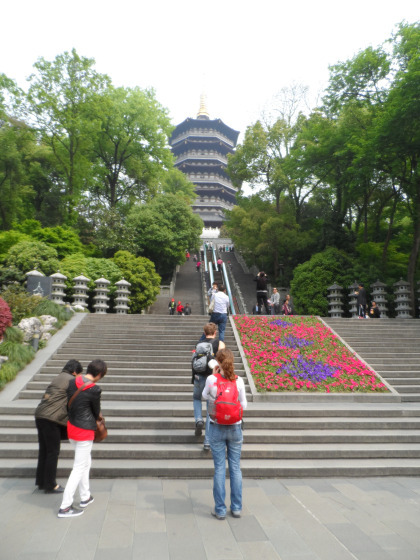


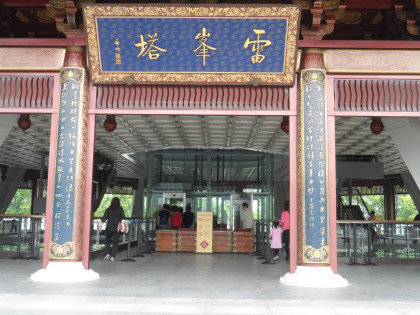
The panoramic views from the higher levels are magnificent, with a few small boats slowly cruising in the peaceful and serene lake, and distant hills in the background, one can easily imagine the sceneries in traditional Chinese landscape paintings coming to life.

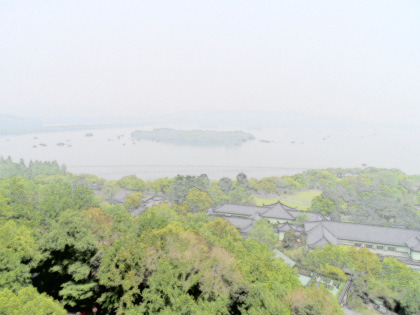
The original pagoda was built in 975 by a king who decided to celebrate the birth of his son. The building survived for centuries, but a local tradition eventually led to its collapse in 1924. The tradition was to take a number of bricks from the base of the building, as luck signs.
The pagoda was rebuilt in 2000 on the site of the original pagoda, so that the building is not only a religious building, but also preserves the remains of the ancient building.

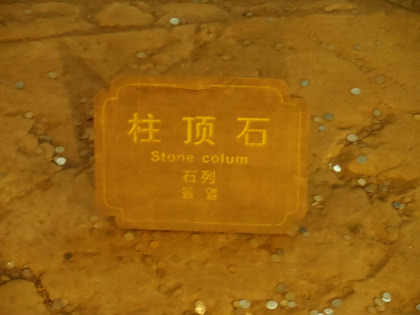

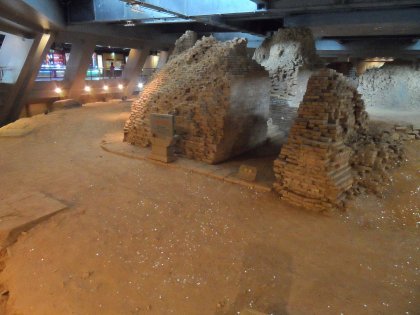
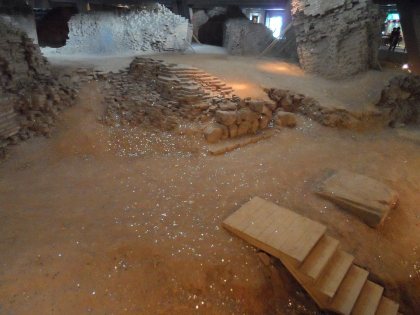
On the ground floor of the building, you can see the remains of the original pagoda and on each floor you will be impressed by the reliefs and the paintings along the rounded walls.






The walk to the Lei Feng Pagoda and around West Lake is lovely. We enjoyed the grounds and the views are outstanding. The pagoda itself is an interesting story, the building style intriguing and the art work impressive. Certainly worth a visit
Best Times for Visiting West Lake
West Lake is suitable for visiting all year round. The scenery varies according to the weather, and season.
Spring — Best Season
Spring (March to May) is the best season for enjoying the lake. Green leaves and flower blossoms enhance its beauty. March and April are the peak season for West Lake travel.
Summer — Lotus Blossoms
Summer (June to August) is the season of lotus flowers. The lotuses attract many people.
“Lotus in the Breeze at Crooked Courtyard�� (a classic West Lake sight) is the best place to see in summer. It is an area by the western shore of the lake. Every summer, there are hundreds of types of lotus in full bloom, attracting many visitors.
Fall — Calm Lake and Clear Sky
Fall (September to November) is cool at West Lake. The weather is less rainy, which makes it a good season for walking round or leisurely boating on the lake. West Lake is also a popular place for observing the full moon at Mid-Autumn Festival.
Winter — “Melting Snow on Broken Bridge”
“Melting Snow on Broken Bridge” is one highlight of winter. The bridge is not only famous for its snowy scenery, but also for its romantic legend. It was on the Broken Bridge that Bai Suzhen first met her lover, Xu Xian. Then the romance blossomed.
Winter (December to February) at West Lake is very cold and wet. Sometimes it snows. The lake in snowy surroundings is a different, still spectacular, sight. Winter is really a good season for enjoying a less-crowded West Lake.
Entrance Fee
West Lake is a large open lake area which welcomes tourists for free. However, admission fees will be charged to visit some scenic spots around.
Attractions Opening Hours Ticket Price West Lake All day long Free of Charge Lei Feng Pagoda Mar. 16 – Apr.: 08:00 – 19:00 May – Oct.: 08:00 – 20:00 Nov. – Mar. 15: 08:00 – 17:30 Ticket selling stops half an hour before closing. CNY 40; Free for children less than 1.2 meters. Three Pools Mirroring the Moon 8:00- 17:00 CNY 55 (including the boat ticket)
Public Transport to West Lake
By Metro: Hangzhou Railway Station
The subway stop at the railway station is called Chengzhan Station (城站)
Take line 1 (red line), which is also the only line here, towards either Linping Station (临平) or Xiasha Jiangbing Station (下沙江滨). Both of these are terminal stations for line 1
Get off in at Ding’an Road Station (定安路), which is just 1 stop from the railway station. Or get off at Longxianggiao Station (龙翔桥), which is 2 stops from the railway station. Ding’an Road Station is slightly farther from the lake, about 10-minutes walk. Longxiangqiao is very close, just 2 blocks away
The subway ride is 10-15 minutes
By Metro : Hangzhou East Railway Station
The only good option is to take the subway line 1 (red line). There are 2 subway lines here so make sure you get on the right one. The line you shouldn’t take is blue
Take line 1 towards Xianghu Station (湘湖)
Get off in 6 stops at Longxiangqiao Station (龙翔桥) or 7 stops at Ding’an Road Station (定安路). Longxiangqiao is closer to the lake just 2 blocks away. Ding’an Road Station is about 10-minute walk from the lake
The subway ride will take 20-30 minutes
By Bus:
Take bus 4, 31, 51, 52, 87, 314, 315, 334, 822, JY6, Y2 or y10 to Sudi (Su Causeway).
Take bus 7, 324, 807, J1, or Y2 to Lingyin.
Take bus 7, 27, 51, 52 or 118 to Yuemiao (Tomb of General Yue Fei).
Take bus 27 or 87 to Shuangfeng or Longjingsi (Longjing Temple).
Take bus 7 or 25 to Hubin
West Lake (Xi Hu) & Lei Feng Pagoda When you visit Hangzhou, you cannot miss West Lake. It’s a center attraction and is a heritage site declared by UNESCO World Heritage.
0 notes
Text
HAPPY COLUMBUS DAY!! October 14, 2019 Christopher Columbus before 31 October 1451 – 20 May 1506) was an Italian explorer, navigator, and colonist who completed four voyages across the Atlantic Ocean under the auspices of the Catholic Monarchs of Castile and Aragon. He led the first European expeditions to the Caribbean, Central America, and South America, initiating the permanent European colonization of the Americas. Columbus discovered a viable sailing route to the Americas, a continent that was then unknown to the Old World. While what he thought he had discovered was a route to the Far East, he is credited with the opening of the Americas for conquest and settlement by Europeans.
Columbus's early life is somewhat obscure, but scholars generally agree that he was born in the Republic of Genoa and spoke a dialect of Ligurian as his first language. He went to sea at a young age and travelled widely, as far north as the British Isles (and possibly Iceland) and as far south as what is now Ghana. He married Portuguese noblewoman Filipa Moniz Perestrelo and was based in Lisbon for several years, but later took a Castilian mistress; he had one son with each woman. Though largely self-educated, Columbus was widely read in geography, astronomy, and history. He formulated a plan to seek a western sea passage to the East Indies, hoping to profit from the lucrative spice trade.
After Columbus lobbied them for years, the Catholic Monarchs of Castile and Aragon agreed to sponsor a journey west, in the name of the Crown of Castile. Columbus left Castile in August 1492 with three ships, and after a stopover in the Canary Islands made landfall in the Americas on 12 October (now celebrated as Columbus Day). His landing place was an island in the Bahamas, known by its native inhabitants as Guanahani; its exact location is uncertain. Columbus subsequently visited Cuba and Hispaniola, establishing a colony in what is now Haiti—the first European settlement in the Americas since the Norse colonies almost 500 years earlier. He arrived back in Castile in early 1493, bringing a number of captive natives with him. Word of his discoveries soon spread throughout Europe.
Columbus made three further voyages to the New World, exploring the Lesser Antilles in 1493, Trinidad and the northern coast of South America in 1498, and the eastern coast of Central America in 1502. Many of the names he gave to geographical features—particularly islands—are still in use. He continued to seek a passage to the East Indies, and the extent to which he was aware that the Americas were a wholly separate landmass is uncertain; he gave the name indios ("Indians") to the indigenous peoples he encountered. Columbus's strained relationship with the Spanish crown and its appointed colonial administrators in America led to his arrest and removal from Hispaniola in 1500, and later to protracted litigation over the benefits that he and his heirs claimed were owed to them by the crown.
Columbus's expeditions inaugurated a period of exploration, conquest, and colonization that lasted for centuries, helping create the modern Western world. The transfers between the Old World and New World that followed his first voyage are known as the Columbian exchange, and the period of human habitation in the Americas prior to his arrival is known as the Pre-Columbian era. Columbus's legacy continues to be debated. He was widely venerated in the centuries after his death, but public perceptions have changed as recent scholars have given attention to negative aspects of his life, such as his role in the extinction of the Taíno people, his promotion of slavery, and allegations of tyranny towards Spanish colonists. Many landmarks and institutions in the Western Hemisphere bear his name, including the country of Colombia.
Celebration of Christopher Columbus's voyage in the early United States is recorded from as early as 1792. The Tammany Society in New York City (for whom it became an annual tradition) and the Massachusetts Historical Society in Boston celebrated the 300th anniversary of Columbus' landing in the New World. President Benjamin Harrison called upon the people of the United States to celebrate Columbus's landing in the New World on the 400th anniversary of the event. During the anniversary in 1892, teachers, preachers, poets and politicians used rituals to teach ideals of patriotism. These rituals took themes such as citizenship boundaries, the importance of loyalty to the nation, and the celebration of social progress.
Many Italian-Americans observe Columbus Day as a celebration of their heritage, and the first such celebration was held in New York City on October 12, 1866. The day was first enshrined as a legal holiday in the United States through the lobbying of Angelo Noce, a first generation Italian, in Denver. The first statewide holiday was proclaimed by Colorado governor Jesse F. McDonald in 1905, and it was made a statutory holiday in 1907. In April 1934, as a result of lobbying by the Knights of Columbus and New York City Italian leader Generoso Pope, Congress and President Franklin Delano Roosevelt proclaimed October 12 be a federal holiday under the name Columbus Day.
Since 1971 (Oct. 11), the holiday has been attributed to the second Monday in October, coincidentally exactly the same day as Thanksgiving in neighboring Canada since 1957. It is generally observed nowadays by banks, the bond market, the U.S. Postal Service, other federal agencies, most state government offices, many businesses, and most school districts. Some businesses and some stock exchanges remain open, and some states and municipalities abstain from observing the holiday.[20] The traditional date of the holiday also adjoins the anniversary of the United States Navy (founded October 13, 1775), and thus both occasions are customarily observed by the Navy and the Marine Corps with either a 72- or 96-hour liberty period.
Love, Debbie
0 notes
Text
Petersen Magazines Overflowed With L.A. Rodders, Racers & Customizers in 1961
Heaven. Granted, the City of Angels ain’t what it was at the turn of the 1960s. Bashing all things Cali is as fashionable today as moving west was six decades ago. Indeed, gearheads elsewhere can now make excellent arguments for automotive scenes wherever they happen to live. Truth be known, high-ranking Eastern and Midwestern executives employed by one of the investment groups that acquired the former Petersen Publishing Company argued that the whole shebang—including the millions of irreplaceable negatives and transparencies in the precious photography archive—rightly belonged on the Right Coast. Their first choice was Florida, insisting that Florida is the California of the 21st-century for all things automotive. They might’ve been right. They’re all gone now (whew, close call!).
While it’s a fact that bare-bones travel budgets usually kept Petersen’s skeleton crews close to home, staffers needn’t have ventured beyond L.A.’s vast city limits to fill every page of every 1961 HOT ROD, Car Craft, Rod & Custom, Motor Trend, Kart, and Motor Life with worthy editorial material. New trends ignited out west were hungrily awaited by millions of monthly readers across North America. Armchair sociologists will be forever debating causation for the hobby’s post-WWII convergence and explosion here. Two of the movement’s main influencers and beneficiaries offered very different reasons on the day that chief photographer Bob D’Olivo captured the mug shots accompanying this article. George Barris and Ed Roth didn’t agree on much else, either, beyond fiberglass sculpting being less expensive than full-custom metalwork; Petersen’s magazines and major car shows enabling eastern builders to close the styling gap with the west; and Los Angeles being the center of hot rodding’s universe.
Another believer was Tom Wolfe, a virtually unknown and entirely nonautomotive New York newspaper reporter whose assignment to cover a local rod-and-custom show inspired a story pitch to Esquire. The editors bit and flew him off to (where else?) SoCal, where HRM’s Tex Smith introduced local heroes and showed Tom around Burbank’s eye-opening Teen Fair. The resultant article, which Esquire titled, “There Goes (Varoom! Varoom!) That Kandy Kolored (Thphhhhhh!) Tangerine-Flake Streamline Baby (Rahghhhh!) Around the Bend (Brummmmmmmmmmmmmmmm…),” led to a best-selling first book that brought widespread fame to the author and two interview subjects previously known only to magazine readers: Barris and Roth.
Nobody working here is old enough to have formed firsthand opinions about alleged regional bias by “those California magazine guys,” but the extent of the state’s influence is unmistakable throughout the thousands of images composed by staff photojournalists in 1961 and considered for HRD’s ongoing series. Skeptics from Someplace Else, USA, who never made the scene, are forgiven for continuing to profess that Southern California subjects, in particular, received vastly disproportionate barrels of ink simply because most magazines happened to be produced there.
“Those people have it exactly backwards,” suggests historian Greg Sharp, a native Angeleno old enough to know. “The magazines were here because the action was here, period. End of story!”
While other carmakers more or less observed the industrywide Automobile Manufacturers Association agreement to avoid sponsoring motorsports or promoting performance, Pontiac Motor Division gained a winning reputation and unprecedented market share by discreetly funneling parts, engineers, and street vehicles to a network of independent skunkworks. Leading the straight-line assault was Mickey Thompson, whose factory involvement is evident in the engines and Pontiac-powered Dragmaster rails crowding his Long Beach facility when HRM photographer Eric Rickman made one of his regular visits. “America’s Speed King” continued repaying his factory favors this season by using eight-, four-, and two-cylinder Pontiac powerplants exclusively to add 14 international and national records for the standing-start mile and kilometer to his unrivaled resume. (See Sept. 1961 HRM; Oct. 1961 HRM, MT, CC & ML; Mar. 2012 & Nov. 2016 HRD.)
Just as Ed Roth’s all-fiberglass Excaliber/Outlaw created controversy in 1959-1960 by redefining the T roadster, this year’s follow-up broke further from traditional hot rods. The Beatnik Bandit began as sketches drawn by regular Rod & Custom contributor Joe Henning in response to Roth’s desire for “something like the Outlaw, only in coupe form.” Less than a year later, Roth’s vision of a futuristic hot rod rolled into the San Mateo (CA) Custom, Rod and Sports Car Show. The one-piece shell wrapped around a shortened ‘55 Oldsmobile chassis and drivetrain. A conventional, functional, lavishly chromed Olds engine by Fritz Voigt (Mickey Thompson’s builder) was revved by a floor-mounted joystick that additionally controlled steering, shifting, and braking. On setup night, R&C staffer Neal East snapped this outtake to the small photo from the same spot that ran in the June 1961 issue.
Ray Callejo stretched tradition, literally, to double his ‘31 Tudor’s displacement to a whopping 584 ci. Yes, this is one Backstage Past image that has already been published, but it’s the only one we found of a homebuilt hot rod too neat to ignore. Although the drag car later earned an entire Car Craft feature, the negatives for those photos presumably remained with freelance contributor Dave Cunningham. Callejo was evidently still working the bugs out of the combination, as the 124-mph top speed reported by CC came previously, with a single 292ci Chevy. (See June 1961 HRM; Oct. 1961 CC.)
Ah, life must have been good for one of Hollywood’s most-eligible bachelors! None of our sources could identify Robert E. Petersen’s apparent date for Motor Trend’s Car of the Year (Pontiac Tempest) reception, though historian Greg Sharp contributed the best wisecrack. Referencing a Jan. 2019 HRD photo of the publisher’s personal sports car nose-down in a neighbor’s yard, Sharp suggested, “Maybe she made up with Pete after rolling the Mercedes down the hill.”
In one historic frame at Motor Trend’s January cocktail party, Petersen staff photographer Pat Brollier captured the most-powerful trio in hot rodding, drag racing, and land-speed racing. Wally Parks (center) was both the president of NHRA and the editorial director for Bob Petersen (back turned). Mickey Thompson, who recently became world’s fastest (406 mph) with Pontiac power and was leading development of the Tempest four-banger for racing, joined the L.A. celebration for the new compact’s Car of the Year selection. (See Mar. 1961 MT; July 1961 HRM.)
Car Craft staffer Bud Lang’s sequence captured Ed Roth’s plastic bubbletop in action during the NHRA Winternationals car show that preceded the inaugural Pomona national event. A remote control box operated the canopy and started the engine. The unquestionable star of the show inexplicably came up empty in judging for the top trophies, scoring only Best Engine Compartment. That slight by NHRA officials was said to inspire Roth’s withdrawal from future competition in favor of guaranteed appearance money and/or free booth space for painting and selling so-called “weirdo” or “monster” shirts. (See May & July 1961 R&C; May 1961 & Feb. 1962 CC; June 1961 HRM; Mar. 2012 HRD.)
Charles “Boogie” Scott’s record-setting horsepower must have impressed chief HOT ROD photographer Eric Rickman, who tracked down the Olds-motivated Deuce in Pomona’s staging lanes for a rare, candid crew shot. (With just 12 frames per roll of medium-format 120 film, action shooters were understandably reluctant to devote film to mug shots unlikely to interest editors.) Also impressive was the long haul from Louisiana in a ‘51 Ford woody tow car by (from right) Henry Penedo, Cliff Smith, Scott, and Gary Lee. Boogie was denied a Winternationals trophy in the A/Altered final round but earned the national e.t. record in 11.15 seconds, while tying the class-record speed of 140.75 mph (See May 1961 HRM). NHRA Museum historian Greg Sharp reminds us that 45 years later, the 70-year-old chassis builder joined Bonneville’s 200-MPH Club in his Gas Modified roadster at 238.508.
A week after becoming Stock Eliminator at the inaugural Winternationals with his ‘61 Impala, Don Nicholson (right) was a logical choice to participate in Motor Life’s test of Chevrolet’s new 409/409 option. Amazingly, the Chevy that he brought—possibly even drove—to Riverside International Raceway was almost certainly the Pomona-winning race car (this license plate checks out). Unbelievably, he allowed a magazine guy to burn rubber and bang gears in it. Note Petersen’s analog “fifth-wheel” data logger and the dust storm stirred up by fenderwell headers. Bob D’Olivo shot the scene and believes the test driver to be former Motor Trend writer Wayne Thoms.
Petersen conceived Motor Life’s awards ceremony as an annual March event recognizing outstanding drivers, mechanics, car owners, promoters, and racing journalists from each preceding season. Neither the awards program nor the magazine would survive the new year, however. The first—and last—Men of the Year lineup included (from left): Carroll Shelby; Henry Banks (accepting for Official of the Year Harlan Fengler); A.J. Foyt, named overall Driver of the Year; Mrs. Robert Bowes (for son Bob Bowes); George Bignotti; Jack Chrisman; Louis Clements; Rex White; Bob Colvin; and Russ Catlin (for writer Max Muhleman). Not shown is Mickey Thompson, honored for his one-way 406.600 at Bonneville. After the November issue, Motor Life—a title intermittently produced by various publishers since the early 20th century—would be absorbed and replaced by a new Petersen monthly, Sports Car Graphic. (See June 1961 HRM & ML; Dec. 1961 SCG.)
Petersen conceived Motor Life’s awards ceremony as an annual March event recognizing outstanding drivers, mechanics, car owners, promoters, and racing journalists from each preceding season. Neither the awards program nor the magazine would survive the new year, however. The first—and last—Men of the Year lineup included (from left): Carroll Shelby; Henry Banks (accepting for Official of the Year Harlan Fengler); A.J. Foyt, named overall Driver of the Year; Mrs. Robert Bowes (for son Bob Bowes); George Bignotti; Jack Chrisman; Louis Clements; Rex White; Bob Colvin; and Russ Catlin (for writer Max Muhleman). Not shown is Mickey Thompson, honored for his one-way 406.600 at Bonneville. After the November issue, Motor Life—a title intermittently produced by various publishers since the early 20th century—would be absorbed and replaced by a new Petersen monthly, Sports Car Graphic. (See June 1961 HRM & ML; Dec. 1961 SCG.)
This series has spared readers the go-karts that commanded more pages in some Petersen monthlies of the era than hot rods and race cars combined. (You’re welcome!) Two rolls logged into the archive’s film index as simply “Jet Kart” earned this exception. Chief photographer Bob D’Olivo pulled the trigger on color photos for a Kart magazine cover story that none of our collector sources owns (thanks, anyway, Gary Medley and Greg Sharp). All we know is that neither the kart owner’s crash helmet nor his tuner’s crescent wrench dissuaded D’Olivo and fellow staffers from blasting around the company’s Hollywood Boulevard headquarters during the after-hours session in Petersen’s makeshift photo studio. At least Car Craft editor Dick Day donned proper headgear for his turn in the seat.
Before the champ-car industry gradually relocated to Indianapolis, suburban Los Angeles was home to countless open-wheel cars. Even so, it’s hard to believe that two different staffers, shooting for different Petersen magazines, would find such homey scenes on two unknown streets in the same city at virtually the same time—if not on the same April day. Oval-track experts Jim Miller and Greg Sharp each answered our plea for vehicle IDs, and then some. We learned that the Vatis Special was the first of three Kurtis-Kraft J-2 models delivered. At the Brickyard in early May, the brand new car was damaged when Chuck Hulse tangled with two drivers during time trials, repaired just in time for the final day of qualifying, then missed the cut on its only timed attempt. (Hulse also drove the adjacent Kurtis 4000 roadster on dirt tracks this year.) The backyard scene shows camgrinder and Indy veteran Dempsey Wilson aboard the Kuzma-built Casale & Greenman entry that did run the race, placing 16th after its 252-inch Offy’s fuel pump failed on Lap 146 (of 200). The photo archive’s film log reveals that respective Petersen photographers Al Paloczy and Eric Rickman turned their exposed film into the lab just one day apart. (See June 1961 ML & HRM.)
Al Paloczy was hired by Bob D’Olivo as a lab technician but proved capable of shooting creative car features, particularly of customs. Colleague Pat Brollier captured some foolishness while Paloczy was waiting for B&W prints to dry.
George Barris’ signboard insisted that his XPAK 400 “runs on a 5-inch cushion of air,” but spectators at the Tridents Car Club Show don’t seem to be buying it. Nor was satirical R&C contributor Joe Henning. Perhaps biased by his design work and fondness for arch-rival Ed Roth, Henning described a recent Bakersfield show during which George “personally conducted a demonstration of the fabulous air car, during which it rose to microscopic heights.” Harsher still was a subsequent Roth Studios ad hyping Big Daddy’s upcoming Rotar as the “only land, sea, air car to work without gimmicks (no hydraulic jack to make it lift), actually flies!” Barris’ addition of a billowing parachute added drama to the demonstrations, but we have yet to find evidence of the advertised elevation. (See Mar. 1961 CC; May & Sept. 1961 R&C.)
We were seeking some excuse—er, that is, a good reason—to share a negative shot for Motor Life that doesn’t appear in our incomplete collection. We found justification under a May HRM headline that looked like a leftover bit from a goofy April Fools issue: “Tragedy Hits Model Car Field.” The disaster turned out to be the theft of 1,200 cartons containing 15,000 AMT plastic kits of 1961 Ford “customizing convertibles” from a Chicago freight terminal worth $19,000. Coincidentally, when Motor Life visited this unknown factory a month after HOT ROD’s item appeared, the bodies stacking up in front of a lone assembly line worker happened to be hardtop versions of a ‘61 Ford.
Pikes Peak’s big story was the surprising emergence of Fords as contenders in the Stock Car class. Not coincidentally, four of them were freshly outfitted with the factory’s first four-speed transmissions, installed by Bill Stroppe on behalf of Colorado dealers anxious to end GM’s domination on the mountain. Fords qualified 1-2-3, ahead of the favored Chevys, but Curtis Turner (pictured) fell 2.4 seconds behind Louis Unser’s 409 bubbletop on race day. (See Sept. 1961 HRM; Oct. 1961 ML & MT.)
Wally Parks waited until Kent Fuller finished building the first four-engine dragster before banning four-engine cars—all except this one, effectively granting Tommy Ivo an exclusive exhibition act. “NHRA told me, ‘If this thing runs good, we’ll have four-motor cars popping up all over the place,’” Ivo explained in a recent e-mail. What appears to be a suburban L.A. neighborhood was actually an elaborate set on the 20th Century Fox lot (where Century City sits today). HRM’s chosen photo location was the fake street in front of the fake house familiar to millions of viewers of a 1961-1962 series costarring TV Tom and Cynthia Pepper as Roaring ‘20s teens. “It was Eric Rickman’s brainstorm to shoot it on the Margie set and get me grounded from drag racing after [studio execs] saw the car I owned. Nice idea, Eric—not! You might say this was the defining moment when I decided to change careers. I gave up acting for drag racing when the series ended because I never wanted to get grounded again.” A tire-wiper named Don Prudhomme graduated to the seat. The duo charged $500 per local appearance; the kid was paid all of 25 bucks. “Ron Pellegrini took Prudhomme’s place when his now-wife, then-girlfriend Lynn told Don that if he left town again, after touring with me and the twin-engined car in 1960, she wouldn’t wait for him anymore,” Ivo added. “He was grounded! After three years, Pellegrini told me the car was all done, so I sold it to Tom McCourry—who ran it nine more years!” It was restored with the aluminum station-wagon body that Tom Hanna attached in 1966 and resides in a private collection. (See Dec. 1961 HRM; Mar. 2012 & Nov. 2016 HRD.)
The so-called kustomizing kings sat down together with R&C editor Bill Neumann in early December for a lengthy, tape-recorded interview that inexplicably waited until the May and June 1962 issues to surface as excerpts entitled, “Mr. Barris, Meet Mr. Roth.” The show-car world was anxiously awaiting the debut of Rotar, Big Daddy’s answer to George’s much-maligned XPAK 400, and an inevitable battle between so-called air cars. Dig the following exchange: Neumann: Ed, Does Rotar actually fly? Roth: Yes. Neumann: George, does XPAK fly? Barris: Does it fly? It’s an experimental car that will raise in the air. Yes. The same two issues carry a related, two-part episode of Pete Millar’s popular Arin Cee comic strip (starring R&C’s answer to Tom Medley’s Stroker McGurk character in HRM) in which the editor assigns Arin the story behind each man’s desire to reign as the king of kustoms. The last two panels bring the contenders together, suddenly sporting each other’s distinctive style: Ed wears a suit; George has a goatee. Their true motivations are finally revealed at the end: Roth: I wanna be king so I can wear a shirt and tie. All my life I’ve wanted to be like George. Barris: … and I want to be like Big Daddy and grow a beard. (See Apr., May & June 1962 R&C.)
Just guessing, but hard times seemed to be a theme of the company’s holiday party in December. Staff artists produced life-size facsimiles of three bums wearing mug shots of PPC executives. The dummy holding the dismal sales graph appears to be Robert E. Petersen himself. While HRM reported unprecedented sales “crowding 700,000,” a tumultuous year internally saw Pete fold two other titles and replace the entire R&C staff after editor Lynn Wineland, a six-year employee, devoted much of the September issue to a newfound fascination with skydiving.
Mr. Petersen obviously got with the poverty program, panhandling for spare change while wearing a signboard showing discontinued magazines. The dapper dude at left looks like ambitious Dick Day, who’d advanced from contributing cartoonist to current Car Craft editor (later becoming a PPC publisher and vice president).
One of the last “car” features shot this year captured the much-anticipated, ill-fated Rotar. Here, Ed Roth shows the after effects of cramming a six-foot-four Big Daddy under the tiny bubbletop for Bill Neumann’s camera. Powered by dual, unmuffled 650cc Triumph engines sitting on their sides, the remote-controlled hovercraft would soon debut in a Pasadena show and remain a major attraction for two show seasons. Unlike Barris’ XPAK 400, Roth’s version proved adept at rising 4 to 5 inches while “blowing up girls’ skirts,” Roth noted proudly. The fun and the “air-car war” stopped suddenly in Detroit when an oil-starved crankshaft failed at full throttle, blasting bits of aluminum fan blades and plastic into the crowd, seriously injuring at least one bystander. (See Aug., Sept. & Dec. 1961 R&C; Apr. & June 1962 R&C.)
The post Petersen Magazines Overflowed With L.A. Rodders, Racers & Customizers in 1961 appeared first on Hot Rod Network.
from Hot Rod Network https://www.hotrod.com/articles/petersen-magazines-overflowed-l-rodders-racers-customizers-1961/ via IFTTT
0 notes
Text
Snipers. Helicopters. Las Vegas Gears Up for New Year’s Eve.
A camera focuses upon the Las Vegas Strip, where security has been ramped up due to the Oct. 1 massacre there.
LAS VEGAS — With their rifles at the ready for an active shooter, Sergeant Charles Jivapong and half a dozen other police officers moved quickly through an industrial building not far from the airport, trying to determine which victims were alive and which were too far gone to be saved.
This time, it was a drill. But Jivapong remembers when it was real: Less than three months ago he responded to reports of gunfire aimed at thousands of people at a country music concert. In just a few days, Jivapong would be out with his officers once again, this time with more than 300,000 revelers celebrating the start of 2018.
“It’s not really a matter of if it happens again, more like when,” he said. “Something like that really changes your perspective and mindset. It weighs heavily. I find myself scanning overhead all the time, thinking about what will happen if we have to do it all over.”
Las Vegas — and cities around the United States —are preparing for the first New Year’s Eve since the Oct. 1 shooting, when Stephen Paddock shot hundreds of rounds from the 32nd floor of the Mandalay Bay Resort and Casino, killing more than 50 people and wounding hundreds of others. For decades, Dec. 31 has been the biggest night of the year in Las Vegas, drawing tourists from all over the world who come to party with abandon on the Strip.
This year, officers in Las Vegas are being urged to consider the possibility of shootings from elevated positions. They are coordinating with medical personnel from the Fire Department, forming teams who will be ready to respond on the Strip and downtown if there is any kind of mass attack.
Homeland Security officials have classified the night as a top safety priority, sending snipers who will be poised on hotel rooftops, helicopters with tactical security forces, and a hostage rescue team from the Federal Bureau of Investigation. National Guard officers will also be stationed throughout the area, including at the nearby airport.
Other cities are stepping up security, as well.
In Boston, uniformed and undercover officers will be out in force in the center of the city, throughout the neighborhoods, and on subways to ensure the night is safe, according to Police Commissioner William Evans and MBTA Transit Police Chief Kenneth Green.
In addition, Evans said, some officers will be posted on rooftops to look out for threats from an elevated position. That precaution is necessary, he said, in the wake of the Las Vegas shooting in October.
“That is a new reality, unfortunately,” said Evans, who said there were no credible threats to the Boston New Years Eve gathering.
Large trucks will also be placed across streets around Copley Square, the center of First Night activities, to block “any motorist who might try to cause some harm to a crowd,” Evans said, as drivers have done in cities such as New York, London, and Nice, France.
The Las Vegas shooting has prompted the New York Police Department to reassess its New Year’s preparations as well, with the city — and Times Square in particular — long considered likely targets.
Each New Year’s Eve, the New York Police Department, and its counterparts in state and federal law enforcement, face anew the job of securing the highly symbolic spot where the ball drops, to the clamor of up to 1 million spectators packed together.
The Vegas attack has prompted police in New York to re-examine their plans. “We’re saying, ‘Let’s revisit our high-vantage security during events like this,’ ” said Stephen P. Davis, the New York Police Department’s chief spokesman.
The New York department plans to use its rooftop observation teams and counter-snipers across a broader area of real estate than in past years.
In Las Vegas, about 330,000 visitors are expected on the Strip for New Year’s Eve, according to the Las Vegas Convention and Visitors Authority, which puts on a fireworks show from seven rooftops and is billing the event as “America’s Party.”
For years, the Las Vegas Metropolitan Police Department had lobbied federal officials to give New Year’s Eve the Department of Homeland Security’s top special-event assessment rating, which would provide the city with federal officers and resources like intelligence and helicopter teams. A few weeks after the October shooting, the Police Department got word that they would receive the rating.
“We need to be able to focus on multiple shooters, on one or more above ground — we’ve got to multiply our forces,” said Chief Chris Jones, who is overseeing the department’s preparations.
Jones estimated that there would be more than 5,000 local and federal officers along the Strip. Nearly the entire length — roughly 4 miles — will be closed to traffic. Inside police headquarters, officials will closely monitor the city using hundreds of security cameras placed in the heavily trafficked tourist areas.
“We’re watching everything,” Lieutenant Dori Koren said.
Material from the Globe staff is included in this report.
Source Article
The post Snipers. Helicopters. Las Vegas Gears Up for New Year’s Eve. appeared first on TBYYY.
Read full post at: http://www.tbyyy.com/snipers-helicopters-las-vegas-gears-up-for-new-years-eve/
0 notes